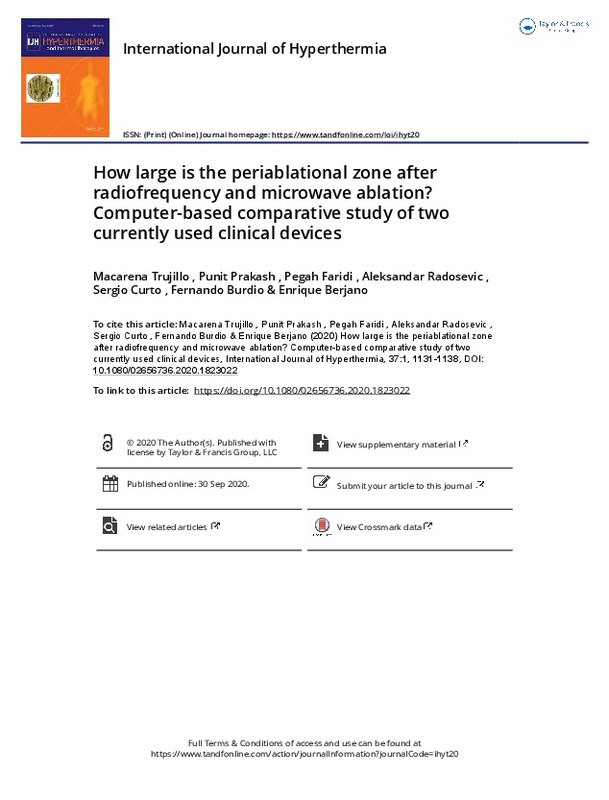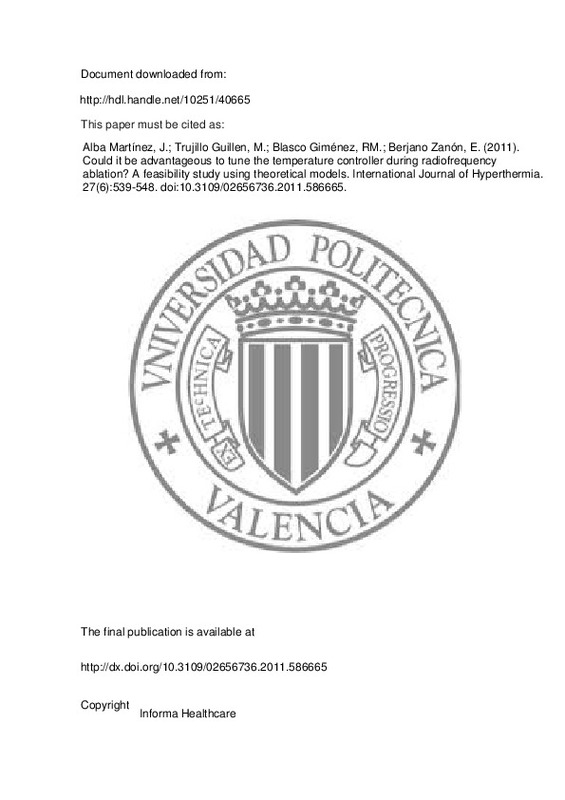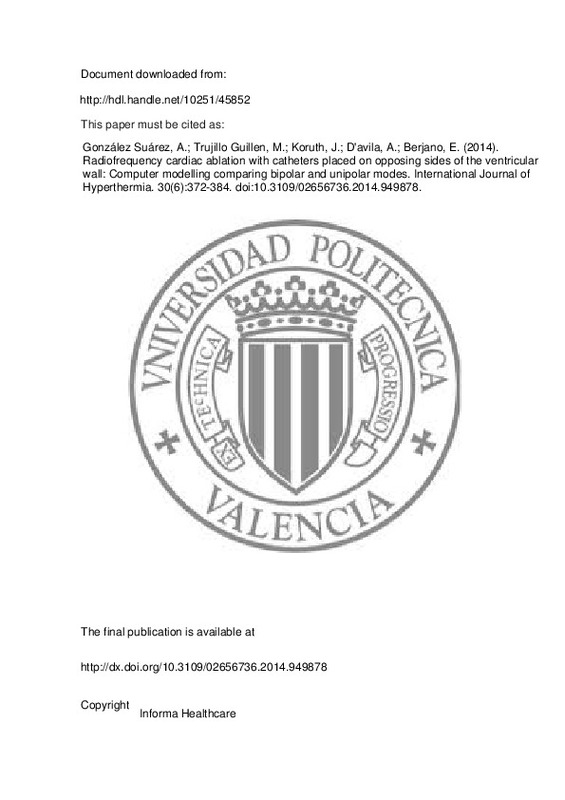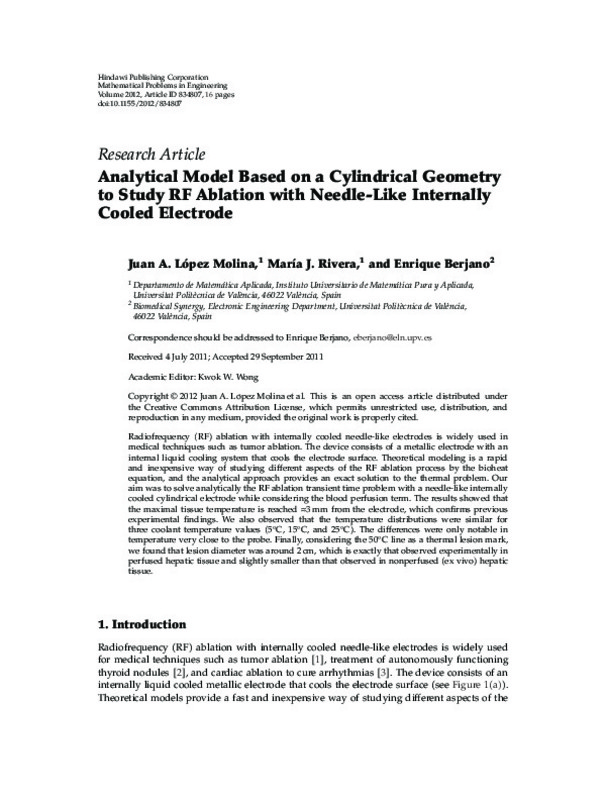JavaScript is disabled for your browser. Some features of this site may not work without it.
Buscar en RiuNet
Listar
Mi cuenta
Estadísticas
Ayuda RiuNet
Admin. UPV
How large is the periablational zone after radiofrequency and microwave ablation? Computer-based comparative study of two currently used clinical devices
Mostrar el registro sencillo del ítem
Ficheros en el ítem
| dc.contributor.author | Trujillo Guillen, Macarena
|
es_ES |
| dc.contributor.author | Prakash, Punit
|
es_ES |
| dc.contributor.author | Faridi, Pegah
|
es_ES |
| dc.contributor.author | Radosevic, Aleksandar
|
es_ES |
| dc.contributor.author | Curto, Sergio
|
es_ES |
| dc.contributor.author | Burdio, Fernando
|
es_ES |
| dc.contributor.author | Berjano, Enrique
|
es_ES |
| dc.date.accessioned | 2021-02-16T04:32:23Z | |
| dc.date.available | 2021-02-16T04:32:23Z | |
| dc.date.issued | 2020-01-01 | es_ES |
| dc.identifier.issn | 0265-6736 | es_ES |
| dc.identifier.uri | http://hdl.handle.net/10251/161387 | |
| dc.description.abstract | [EN] Purpose To compare the size of the coagulation (CZ) and periablational (PZ) zones created with two commercially available devices in clinical use for radiofrequency (RFA) and microwave ablation (MWA), respectively. Methods Computer models were used to simulate RFA with a 3-cm Cool-tip applicator and MWA with an Amica-Gen applicator. The Arrhenius model was used to compute the damage index (omega). CZ was considered when omega > 4.6 (>99% of damaged cells). Regions with 0.6<omega < 2.1 were considered as the PZ (tissue that has undergone moderate sub-ablative hyperthermia). The ratio of PZ volume to CZ volume (PZ/CZ) was regarded as a measure of performance, since a low value implies achieving a large CZ while keeping the PZ small. Results Ten-min RFA (51 W) created smaller periablational zones than 10-min MWA (11.3 cm(3)vs. 17.2-22.9 cm(3), for 60-100 W MWA, respectively). Prolonging duration from 5 to 10 min increased the PZ in MWA more than in RFA (2.7 cm(3)for RFA vs. 8.3-11.9 cm(3)for 60-100 W MWA, respectively). PZ/CZ for RFA were relatively high (65-69%), regardless of ablation time, while those for MWA were highly dependent on the duration (increase of up to 25% between 5 and 10 min) and on the applied power (smaller values as power was raised, 102% for 60 W vs. 81% for 100 W, both for 10 min). The lowest PZ/CZ across all settings was 56%, obtained with 100 W-5 min MWA. Conclusions Although RFA creates smaller periablational zones than MWA, 100 W-5 min MWA provides the lowest PZ/CZ. | es_ES |
| dc.description.sponsorship | This work was supported by the Spanish Ministerio de Ciencia, Innovacion y Universidades under "Programa Estatal de I+D+i Orientada a los Retos de la Sociedad", Grant No "RTI2018-094357-B-C21". Punit Prakash acknowledges support from NIH grant R01EB028848. This project has also received funding from the European Union's Horizon 2020 research and innovation programme under the Marie SklodowskaCurie grant agreement No 845645. | es_ES |
| dc.language | Inglés | es_ES |
| dc.publisher | Taylor & Francis | es_ES |
| dc.relation.ispartof | International Journal of Hyperthermia | es_ES |
| dc.rights | Reconocimiento (by) | es_ES |
| dc.subject | Microwave ablation | es_ES |
| dc.subject | Moderate hyperthermic heating | es_ES |
| dc.subject | Periablational zone | es_ES |
| dc.subject | Radiofrequency ablation | es_ES |
| dc.subject | Thermal ablation | es_ES |
| dc.subject | Tumor ablation | es_ES |
| dc.subject.classification | TECNOLOGIA ELECTRONICA | es_ES |
| dc.subject.classification | MATEMATICA APLICADA | es_ES |
| dc.title | How large is the periablational zone after radiofrequency and microwave ablation? Computer-based comparative study of two currently used clinical devices | es_ES |
| dc.type | Artículo | es_ES |
| dc.identifier.doi | 10.1080/02656736.2020.1823022 | es_ES |
| dc.relation.projectID | info:eu-repo/grantAgreement/EC/H2020/845645/EU/Optimizing delivery and effectiveness of chemotherapy in breast cancer patients using thermotherapy under image-guidance/ | es_ES |
| dc.relation.projectID | info:eu-repo/grantAgreement/NIH//R01EB028848/ | es_ES |
| dc.relation.projectID | info:eu-repo/grantAgreement/AEI/Plan Estatal de Investigación Científica y Técnica y de Innovación 2017-2020/RTI2018-094357-B-C21/ES/MODELADO Y EXPERIMENTACION PARA TERAPIAS ABLATIVAS INNOVADORAS/ | es_ES |
| dc.rights.accessRights | Abierto | es_ES |
| dc.contributor.affiliation | Universitat Politècnica de València. Departamento de Ingeniería Electrónica - Departament d'Enginyeria Electrònica | es_ES |
| dc.contributor.affiliation | Universitat Politècnica de València. Departamento de Matemática Aplicada - Departament de Matemàtica Aplicada | es_ES |
| dc.description.bibliographicCitation | Trujillo Guillen, M.; Prakash, P.; Faridi, P.; Radosevic, A.; Curto, S.; Burdio, F.; Berjano, E. (2020). How large is the periablational zone after radiofrequency and microwave ablation? Computer-based comparative study of two currently used clinical devices. International Journal of Hyperthermia. 37(1):1131-1138. https://doi.org/10.1080/02656736.2020.1823022 | es_ES |
| dc.description.accrualMethod | S | es_ES |
| dc.relation.publisherversion | https://doi.org/10.1080/02656736.2020.1823022 | es_ES |
| dc.description.upvformatpinicio | 1131 | es_ES |
| dc.description.upvformatpfin | 1138 | es_ES |
| dc.type.version | info:eu-repo/semantics/publishedVersion | es_ES |
| dc.description.volume | 37 | es_ES |
| dc.description.issue | 1 | es_ES |
| dc.identifier.pmid | 32996794 | es_ES |
| dc.identifier.pmcid | PMC7714001 | es_ES |
| dc.relation.pasarela | S\418640 | es_ES |
| dc.contributor.funder | European Commission | es_ES |
| dc.contributor.funder | Agencia Estatal de Investigación | es_ES |
| dc.contributor.funder | National Institutes of Health, EEUU | es_ES |
| dc.description.references | Markezana, A., Ahmed, M., Kumar, G., Zorde-Khvalevsky, E., Rozenblum, N., Galun, E., & Goldberg, S. N. (2020). Moderate hyperthermic heating encountered during thermal ablation increases tumor cell activity. International Journal of Hyperthermia, 37(1), 119-129. doi:10.1080/02656736.2020.1714084 | es_ES |
| dc.description.references | Laeseke, P. F., Lee, F. T., Sampson, L. A., van der Weide, D. W., & Brace, C. L. (2009). Microwave Ablation versus Radiofrequency Ablation in the Kidney: High-power Triaxial Antennas Create Larger Ablation Zones than Similarly Sized Internally Cooled Electrodes. Journal of Vascular and Interventional Radiology, 20(9), 1224-1229. doi:10.1016/j.jvir.2009.05.029 | es_ES |
| dc.description.references | Andreano, A., & Brace, C. L. (2012). A Comparison of Direct Heating During Radiofrequency and Microwave Ablation in Ex Vivo Liver. CardioVascular and Interventional Radiology, 36(2), 505-511. doi:10.1007/s00270-012-0405-1 | es_ES |
| dc.description.references | Shi, J., & Huang, Y. (2019). Comparison of the Ablation and Hyperechoic Zones in Different Tissues Using Microwave and Radio Frequency Ablation. Journal of Ultrasound in Medicine, 38(10), 2611-2619. doi:10.1002/jum.14958 | es_ES |
| dc.description.references | Huang, X., Nie, F., Wa, Z., Hu, H., Huang, Q., Guo, H., … Lu, M.-D. (2018). Thermal Field Distributions of Ablative Experiments Using Cyst-mimicking Phantoms. Academic Radiology, 25(5), 636-642. doi:10.1016/j.acra.2017.11.010 | es_ES |
| dc.description.references | Shibata, T., Niinobu, T., & Ogata, N. (2000). Comparison of the effects of in-vivo thermal ablation of pig liver by microwave and radiofrequency coagulation. Journal of Hepato-Biliary-Pancreatic Surgery, 7(6), 592-598. doi:10.1007/s005340070009 | es_ES |
| dc.description.references | Izzo, F., Granata, V., Grassi, R., Fusco, R., Palaia, R., Delrio, P., … Curley, S. A. (2019). Radiofrequency Ablation and Microwave Ablation in Liver Tumors: An Update. The Oncologist, 24(10). doi:10.1634/theoncologist.2018-0337 | es_ES |
| dc.description.references | Liu, W., Zheng, Y., He, W., Zou, R., Qiu, J., Shen, J., … Yuan, Y. (2018). Microwave vs radiofrequency ablation for hepatocellular carcinoma within the Milan criteria: a propensity score analysis. Alimentary Pharmacology & Therapeutics, 48(6), 671-681. doi:10.1111/apt.14929 | es_ES |
| dc.description.references | Shi, X., Pan, H., Ge, H., Li, L., … Xu, Y. (2019). Subsequent cooling-circulation after radiofrequency and microwave ablation avoids secondary indirect damage induced by residual thermal energy. Diagnostic and Interventional Radiology, 25(4), 291-297. doi:10.5152/dir.2019.17455 | es_ES |
| dc.description.references | Dewey, W. C. (1994). Arrhenius relationships from the molecule and cell to the clinic. International Journal of Hyperthermia, 10(4), 457-483. doi:10.3109/02656739409009351 | es_ES |
| dc.description.references | Chang, I. A., & Nguyen, U. D. (2004). Thermal modeling of lesion growth with radiofrequency ablation devices. BioMedical Engineering OnLine, 3(1). doi:10.1186/1475-925x-3-27 | es_ES |
| dc.description.references | Trujillo, M., Bon, J., José Rivera, M., Burdío, F., & Berjano, E. (2016). Computer modelling of an impedance-controlled pulsing protocol for RF tumour ablation with a cooled electrode. International Journal of Hyperthermia, 32(8), 931-939. doi:10.1080/02656736.2016.1190868 | es_ES |
| dc.description.references | Lopresto, V., Pinto, R., Farina, L., & Cavagnaro, M. (2017). Microwave thermal ablation: Effects of tissue properties variations on predictive models for treatment planning. Medical Engineering & Physics, 46, 63-70. doi:10.1016/j.medengphy.2017.06.008 | es_ES |
| dc.description.references | Pätz, T., Kröger, T., & Preusser, T. (2009). Simulation of Radiofrequency Ablation Including Water Evaporation. World Congress on Medical Physics and Biomedical Engineering, September 7 - 12, 2009, Munich, Germany, 1287-1290. doi:10.1007/978-3-642-03882-2_341 | es_ES |
| dc.description.references | Brace, C. L., Laeseke, P. F., van der Weide, D. W., & Lee, F. T. (2005). Microwave ablation with a triaxial antenna: results in ex vivo bovine liver. IEEE Transactions on Microwave Theory and Techniques, 53(1), 215-220. doi:10.1109/tmtt.2004.839308 | es_ES |
| dc.description.references | Cavagnaro, M., Amabile, C., Bernardi, P., Pisa, S., & Tosoratti, N. (2011). A Minimally Invasive Antenna for Microwave Ablation Therapies: Design, Performances, and Experimental Assessment. IEEE Transactions on Biomedical Engineering, 58(4), 949-959. doi:10.1109/tbme.2010.2099657 | es_ES |
| dc.description.references | Prakash, P. (2010). Theoretical Modeling for Hepatic Microwave Ablation. The Open Biomedical Engineering Journal, 4(1), 27-38. doi:10.2174/1874120701004010027 | es_ES |
| dc.description.references | Vogl, T., Nour-Eldin, N.-E., Hammerstingl, R., Panahi, B., & Naguib, N. (2017). Microwave Ablation (MWA): Basics, Technique and Results in Primary and Metastatic Liver Neoplasms – Review Article. RöFo - Fortschritte auf dem Gebiet der Röntgenstrahlen und der bildgebenden Verfahren, 189(11), 1055-1066. doi:10.1055/s-0043-117410 | es_ES |
| dc.description.references | Irastorza, R. M., d’ Avila, A., & Berjano, E. (2017). Thermal latency adds to lesion depth after application of high-power short-duration radiofrequency energy: Results of a computer-modeling study. Journal of Cardiovascular Electrophysiology, 29(2), 322-327. doi:10.1111/jce.13363 | es_ES |
| dc.description.references | Irastorza, R. M., Trujillo, M., & Berjano, E. (2017). How coagulation zone size is underestimated in computer modeling of RF ablation by ignoring the cooling phase just after RF power is switched off. International Journal for Numerical Methods in Biomedical Engineering, 33(11), e2869. doi:10.1002/cnm.2869 | es_ES |
| dc.description.references | Brace, C. L. (2009). Radiofrequency and Microwave Ablation of the Liver, Lung, Kidney, and Bone: What Are the Differences? Current Problems in Diagnostic Radiology, 38(3), 135-143. doi:10.1067/j.cpradiol.2007.10.001 | es_ES |
| dc.description.references | Curto, S., Taj‐Eldin, M., Fairchild, D., & Prakash, P. (2015). Microwave ablation at 915 MHz vs 2.45 GHz: A theoretical and experimental investigation. Medical Physics, 42(11), 6152-6161. doi:10.1118/1.4931959 | es_ES |
| dc.description.references | Belous, A., & Podhajsky, R. J. (2009). The effect of initial and dynamic liver conditions on RF ablation size: a study in perfused and non-perfused animal models. Energy-based Treatment of Tissue and Assessment V. doi:10.1117/12.809597 | es_ES |
| dc.description.references | Song, K. D., Lee, M. W., Park, H. J., Cha, D. I., Kang, T. W., Lee, J., … Rhim, H. (2015). Hepatic radiofrequency ablation:in vivoandex vivocomparisons of 15-gauge (G) and 17-G internally cooled electrodes. The British Journal of Radiology, 88(1050), 20140497. doi:10.1259/bjr.20140497 | es_ES |
| dc.description.references | Cha, J., Choi, D., Lee, M. W., Rhim, H., Kim, Y., Lim, H. K., … Park, C. K. (2009). Radiofrequency Ablation Zones in Ex Vivo Bovine and In Vivo Porcine Livers: Comparison of the Use of Internally Cooled Electrodes and Internally Cooled Wet Electrodes. CardioVascular and Interventional Radiology, 32(6), 1235-1240. doi:10.1007/s00270-009-9600-0 | es_ES |
| dc.description.references | Solazzo, S. A., Ahmed, M., Liu, Z., Hines-Peralta, A. U., & Goldberg, S. N. (2007). High-Power Generator for Radiofrequency Ablation: Larger Electrodes and Pulsing Algorithms in Bovine ex Vivo and Porcine in Vivo Settings. Radiology, 242(3), 743-750. doi:10.1148/radiol.2423052039 | es_ES |
| dc.description.references | Lee, J. M., Han, J. K., Chang, J. M., Chung, S. Y., Kim, S. H., Lee, J. Y., … Choi, B. I. (2006). Radiofrequency Ablation of the Porcine Liver In Vivo: Increased Coagulation with an Internally Cooled Perfusion Electrode. Academic Radiology, 13(3), 343-352. doi:10.1016/j.acra.2005.10.020 | es_ES |
| dc.description.references | Amabile, C., Ahmed, M., Solbiati, L., Meloni, M. F., Solbiati, M., Cassarino, S., … Goldberg, S. N. (2016). Microwave ablation of primary and secondary liver tumours: ex vivo, in vivo, and clinical characterisation. International Journal of Hyperthermia, 33(1), 34-42. doi:10.1080/02656736.2016.1196830 | es_ES |
| dc.description.references | Kuang, M., Lu, M. D., Xie, X. Y., Xu, H. X., Mo, L. Q., Liu, G. J., … Liang, J. Y. (2007). Liver Cancer: Increased Microwave Delivery to Ablation Zone with Cooled-Shaft Antenna—Experimental and Clinical Studies. Radiology, 242(3), 914-924. doi:10.1148/radiol.2423052028 | es_ES |
| dc.description.references | He, N., Wang, W., Ji, Z., Li, C., & Huang, B. (2010). Microwave Ablation. Academic Radiology, 17(7), 894-899. doi:10.1016/j.acra.2010.03.005 | es_ES |
| dc.description.references | Wang, Y., Sun, Y., Feng, L., Gao, Y., Ni, X., & Liang, P. (2008). Internally cooled antenna for microwave ablation: Results in ex vivo and in vivo porcine livers. European Journal of Radiology, 67(2), 357-361. doi:10.1016/j.ejrad.2007.07.015 | es_ES |
| dc.description.references | UMEHARA, H., SEKI, T., INOKUCHI, R., TAMAI, T., KAWAMURA, R., ASAYAMA, T., … OKAZAKI, K. (2011). Microwave coagulation using a perfusion microwave electrode: Preliminary experimental study using ex vivo and in vivo liver. Experimental and Therapeutic Medicine, 3(2), 214-220. doi:10.3892/etm.2011.380 | es_ES |
| dc.description.references | Chiang, J., Hynes, K. A., Bedoya, M., & Brace, C. L. (2013). A Dual-Slot Microwave Antenna for More Spherical Ablation Zones: Ex Vivo and in Vivo Validation. Radiology, 268(2), 382-389. doi:10.1148/radiol.13122128 | es_ES |
| dc.description.references | Bedoya, M., del Rio, A. M., Chiang, J., & Brace, C. L. (2014). Microwave ablation energy delivery: Influence of power pulsing on ablation results in anex vivoandin vivoliver model. Medical Physics, 41(12), 123301. doi:10.1118/1.4901312 | es_ES |
| dc.description.references | Andreano, A., Huang, Y., Meloni, M. F., Lee, F. T., & Brace, C. (2010). Microwaves create larger ablations than radiofrequency when controlled for power inex vivotissue. Medical Physics, 37(6Part1), 2967-2973. doi:10.1118/1.3432569 | es_ES |
| dc.description.references | Cornelis, F. H., Durack, J. C., Kimm, S. Y., Wimmer, T., Coleman, J. A., Solomon, S. B., & Srimathveeravalli, G. (2017). A Comparative Study of Ablation Boundary Sharpness After Percutaneous Radiofrequency, Cryo-, Microwave, and Irreversible Electroporation Ablation in Normal Swine Liver and Kidneys. CardioVascular and Interventional Radiology, 40(10), 1600-1608. doi:10.1007/s00270-017-1692-3 | es_ES |
| dc.description.references | Kim, H. J., Rhim, H., Lee, M. W., & Jeong, W. K. (2015). Measurement of Intrahepatic Pressure during Microwave Ablation in an Ex Vivo Bovine Liver Model. Gut and Liver, 9(6), 784. doi:10.5009/gnl14272 | es_ES |
| dc.description.references | Faridi, P., Keselman, P., Fallahi, H., & Prakash, P. (2020). Experimental assessment of microwave ablation computational modeling with MR thermometry. Medical Physics, 47(9), 3777-3788. doi:10.1002/mp.14318 | es_ES |











